Leadership and Management: Comprehensive Meeting Procedures Report
VerifiedAdded on 2022/11/30
|10
|2590
|135
Report
AI Summary
This report provides a comprehensive overview of meeting procedures, group dynamics, and leadership principles. It begins by defining key meeting terminology such as agenda, quorum, and minutes. The report then outlines the structures of both formal and informal meetings, including essential arrangements like location and equipment. It details the responsibilities of a chairperson before and during meetings, emphasizing the importance of monitoring participation and managing challenging behaviors. The report delves into group dynamics, offering strategies for handling dominant or shy participants, and managing private conversations. It defines various roles within a meeting, such as initiator and distractor. The report also discusses different methods of conducting meetings, highlighting the advantages of face-to-face and virtual meetings, including the use of webcams and video conferencing software. It explains the purpose and components of agendas and meeting minutes, differentiating between formal and informal minutes. Finally, the report references the Corporations Act 2001 regarding meeting notices and identifies relevant organizational policies and procedures for conducting meetings.
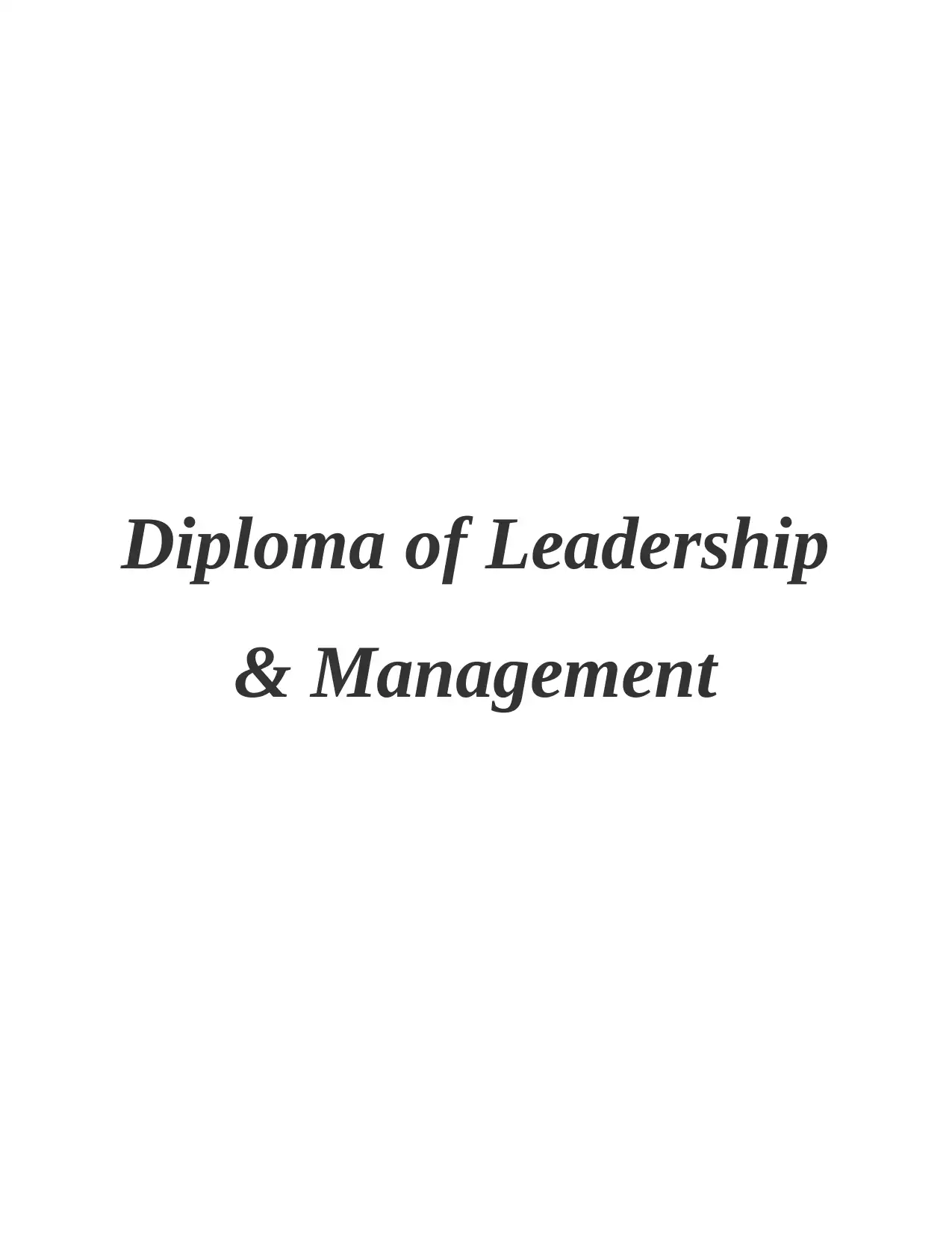
Diploma of Leadership
& Management
& Management
Paraphrase This Document
Need a fresh take? Get an instant paraphrase of this document with our AI Paraphraser
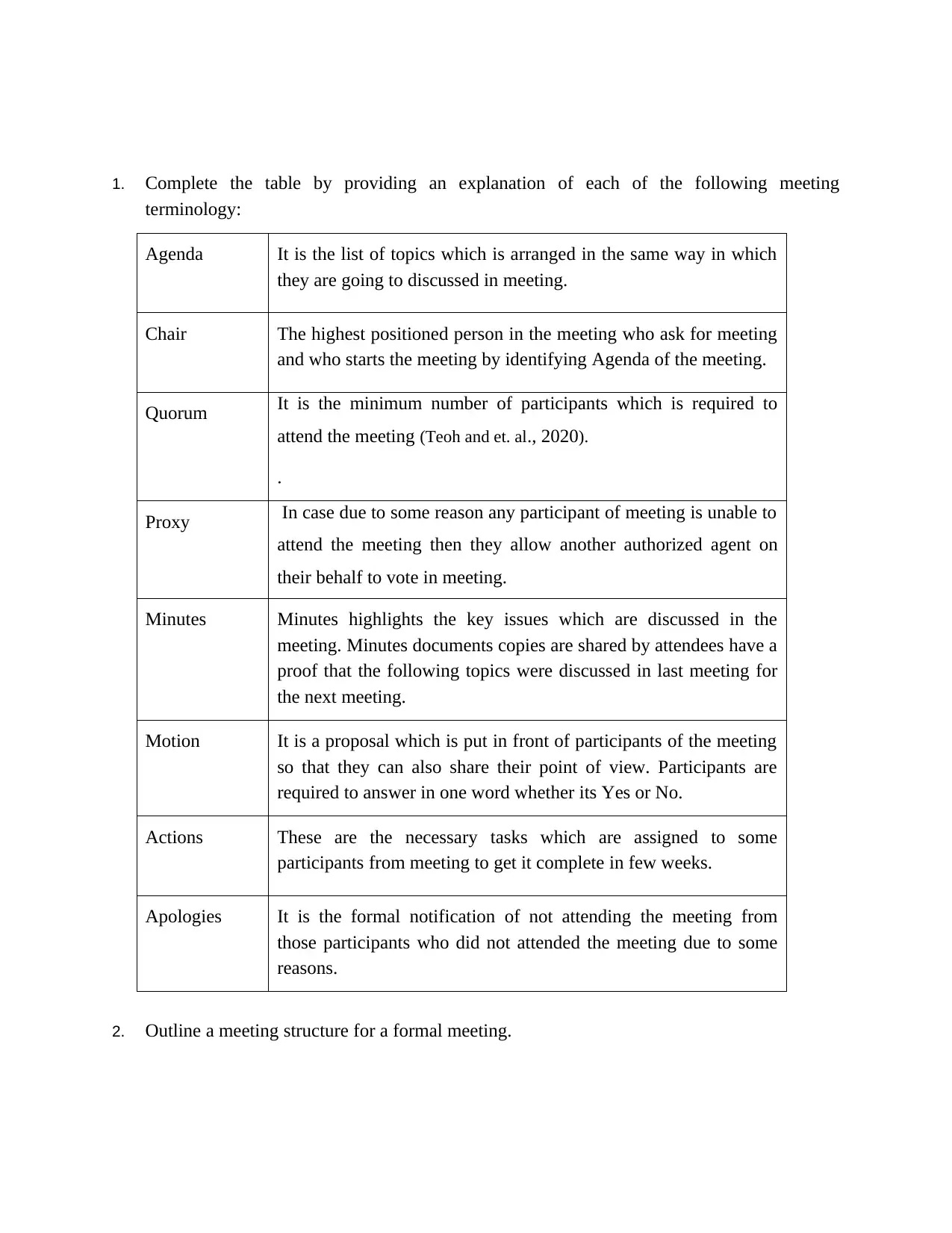
1. Complete the table by providing an explanation of each of the following meeting
terminology:
Agenda It is the list of topics which is arranged in the same way in which
they are going to discussed in meeting.
Chair The highest positioned person in the meeting who ask for meeting
and who starts the meeting by identifying Agenda of the meeting.
Quorum It is the minimum number of participants which is required to
attend the meeting (Teoh and et. al., 2020).
.
Proxy In case due to some reason any participant of meeting is unable to
attend the meeting then they allow another authorized agent on
their behalf to vote in meeting.
Minutes Minutes highlights the key issues which are discussed in the
meeting. Minutes documents copies are shared by attendees have a
proof that the following topics were discussed in last meeting for
the next meeting.
Motion It is a proposal which is put in front of participants of the meeting
so that they can also share their point of view. Participants are
required to answer in one word whether its Yes or No.
Actions These are the necessary tasks which are assigned to some
participants from meeting to get it complete in few weeks.
Apologies It is the formal notification of not attending the meeting from
those participants who did not attended the meeting due to some
reasons.
2. Outline a meeting structure for a formal meeting.
terminology:
Agenda It is the list of topics which is arranged in the same way in which
they are going to discussed in meeting.
Chair The highest positioned person in the meeting who ask for meeting
and who starts the meeting by identifying Agenda of the meeting.
Quorum It is the minimum number of participants which is required to
attend the meeting (Teoh and et. al., 2020).
.
Proxy In case due to some reason any participant of meeting is unable to
attend the meeting then they allow another authorized agent on
their behalf to vote in meeting.
Minutes Minutes highlights the key issues which are discussed in the
meeting. Minutes documents copies are shared by attendees have a
proof that the following topics were discussed in last meeting for
the next meeting.
Motion It is a proposal which is put in front of participants of the meeting
so that they can also share their point of view. Participants are
required to answer in one word whether its Yes or No.
Actions These are the necessary tasks which are assigned to some
participants from meeting to get it complete in few weeks.
Apologies It is the formal notification of not attending the meeting from
those participants who did not attended the meeting due to some
reasons.
2. Outline a meeting structure for a formal meeting.
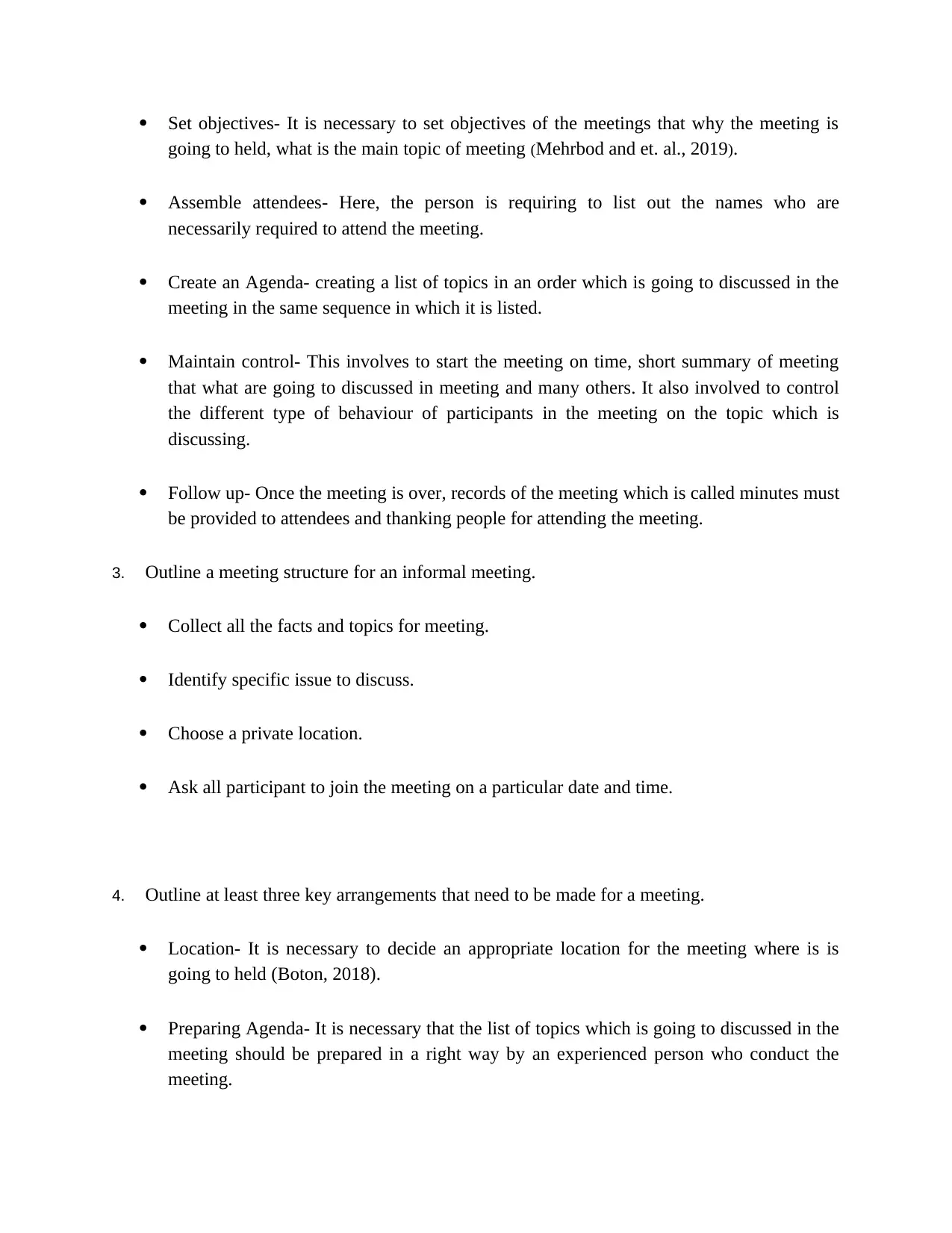
Set objectives- It is necessary to set objectives of the meetings that why the meeting is
going to held, what is the main topic of meeting (Mehrbod and et. al., 2019).
Assemble attendees- Here, the person is requiring to list out the names who are
necessarily required to attend the meeting.
Create an Agenda- creating a list of topics in an order which is going to discussed in the
meeting in the same sequence in which it is listed.
Maintain control- This involves to start the meeting on time, short summary of meeting
that what are going to discussed in meeting and many others. It also involved to control
the different type of behaviour of participants in the meeting on the topic which is
discussing.
Follow up- Once the meeting is over, records of the meeting which is called minutes must
be provided to attendees and thanking people for attending the meeting.
3. Outline a meeting structure for an informal meeting.
Collect all the facts and topics for meeting.
Identify specific issue to discuss.
Choose a private location.
Ask all participant to join the meeting on a particular date and time.
4. Outline at least three key arrangements that need to be made for a meeting.
Location- It is necessary to decide an appropriate location for the meeting where is is
going to held (Boton, 2018).
Preparing Agenda- It is necessary that the list of topics which is going to discussed in the
meeting should be prepared in a right way by an experienced person who conduct the
meeting.
going to held, what is the main topic of meeting (Mehrbod and et. al., 2019).
Assemble attendees- Here, the person is requiring to list out the names who are
necessarily required to attend the meeting.
Create an Agenda- creating a list of topics in an order which is going to discussed in the
meeting in the same sequence in which it is listed.
Maintain control- This involves to start the meeting on time, short summary of meeting
that what are going to discussed in meeting and many others. It also involved to control
the different type of behaviour of participants in the meeting on the topic which is
discussing.
Follow up- Once the meeting is over, records of the meeting which is called minutes must
be provided to attendees and thanking people for attending the meeting.
3. Outline a meeting structure for an informal meeting.
Collect all the facts and topics for meeting.
Identify specific issue to discuss.
Choose a private location.
Ask all participant to join the meeting on a particular date and time.
4. Outline at least three key arrangements that need to be made for a meeting.
Location- It is necessary to decide an appropriate location for the meeting where is is
going to held (Boton, 2018).
Preparing Agenda- It is necessary that the list of topics which is going to discussed in the
meeting should be prepared in a right way by an experienced person who conduct the
meeting.
⊘ This is a preview!⊘
Do you want full access?
Subscribe today to unlock all pages.

Trusted by 1+ million students worldwide
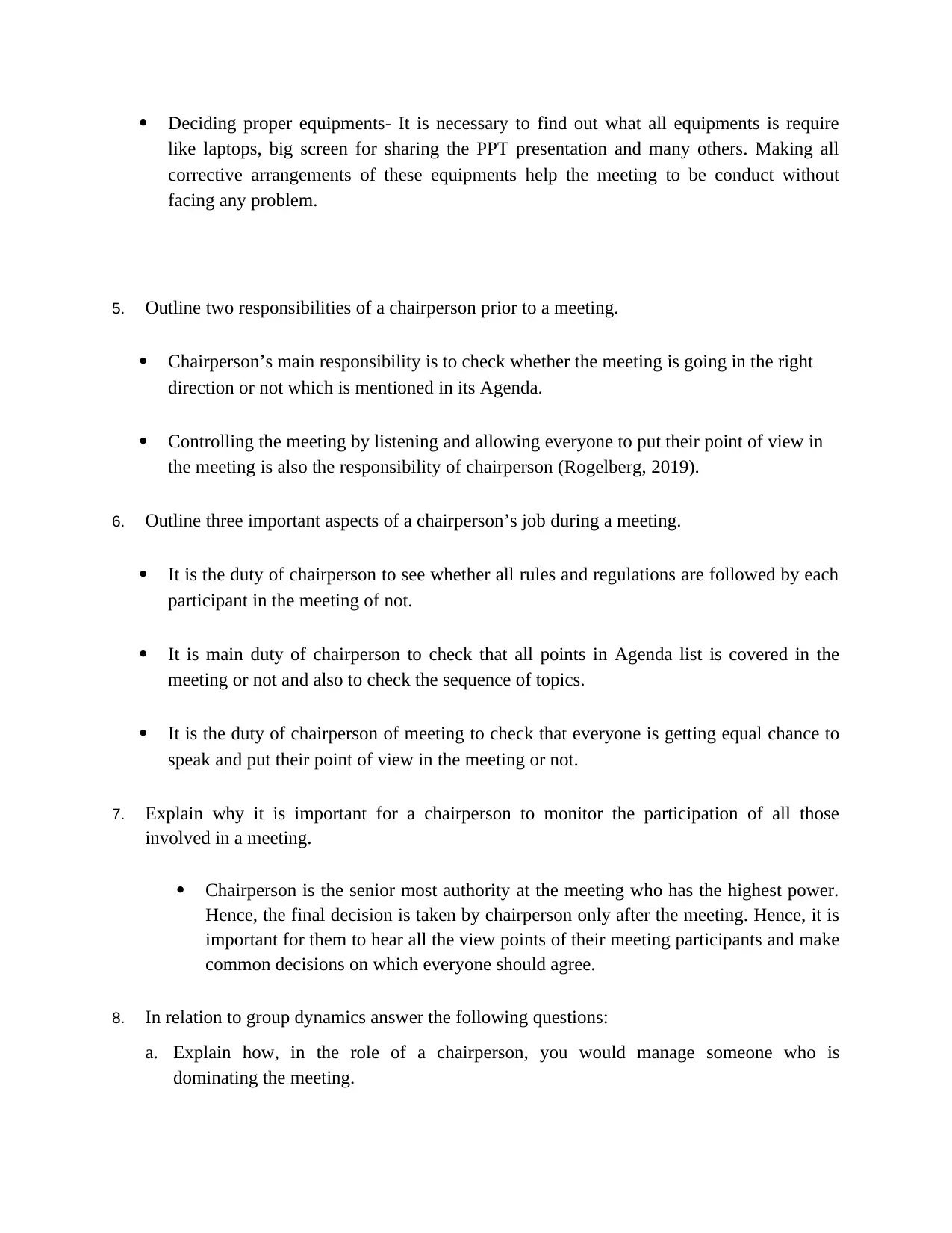
Deciding proper equipments- It is necessary to find out what all equipments is require
like laptops, big screen for sharing the PPT presentation and many others. Making all
corrective arrangements of these equipments help the meeting to be conduct without
facing any problem.
5. Outline two responsibilities of a chairperson prior to a meeting.
Chairperson’s main responsibility is to check whether the meeting is going in the right
direction or not which is mentioned in its Agenda.
Controlling the meeting by listening and allowing everyone to put their point of view in
the meeting is also the responsibility of chairperson (Rogelberg, 2019).
6. Outline three important aspects of a chairperson’s job during a meeting.
It is the duty of chairperson to see whether all rules and regulations are followed by each
participant in the meeting of not.
It is main duty of chairperson to check that all points in Agenda list is covered in the
meeting or not and also to check the sequence of topics.
It is the duty of chairperson of meeting to check that everyone is getting equal chance to
speak and put their point of view in the meeting or not.
7. Explain why it is important for a chairperson to monitor the participation of all those
involved in a meeting.
Chairperson is the senior most authority at the meeting who has the highest power.
Hence, the final decision is taken by chairperson only after the meeting. Hence, it is
important for them to hear all the view points of their meeting participants and make
common decisions on which everyone should agree.
8. In relation to group dynamics answer the following questions:
a. Explain how, in the role of a chairperson, you would manage someone who is
dominating the meeting.
like laptops, big screen for sharing the PPT presentation and many others. Making all
corrective arrangements of these equipments help the meeting to be conduct without
facing any problem.
5. Outline two responsibilities of a chairperson prior to a meeting.
Chairperson’s main responsibility is to check whether the meeting is going in the right
direction or not which is mentioned in its Agenda.
Controlling the meeting by listening and allowing everyone to put their point of view in
the meeting is also the responsibility of chairperson (Rogelberg, 2019).
6. Outline three important aspects of a chairperson’s job during a meeting.
It is the duty of chairperson to see whether all rules and regulations are followed by each
participant in the meeting of not.
It is main duty of chairperson to check that all points in Agenda list is covered in the
meeting or not and also to check the sequence of topics.
It is the duty of chairperson of meeting to check that everyone is getting equal chance to
speak and put their point of view in the meeting or not.
7. Explain why it is important for a chairperson to monitor the participation of all those
involved in a meeting.
Chairperson is the senior most authority at the meeting who has the highest power.
Hence, the final decision is taken by chairperson only after the meeting. Hence, it is
important for them to hear all the view points of their meeting participants and make
common decisions on which everyone should agree.
8. In relation to group dynamics answer the following questions:
a. Explain how, in the role of a chairperson, you would manage someone who is
dominating the meeting.
Paraphrase This Document
Need a fresh take? Get an instant paraphrase of this document with our AI Paraphraser
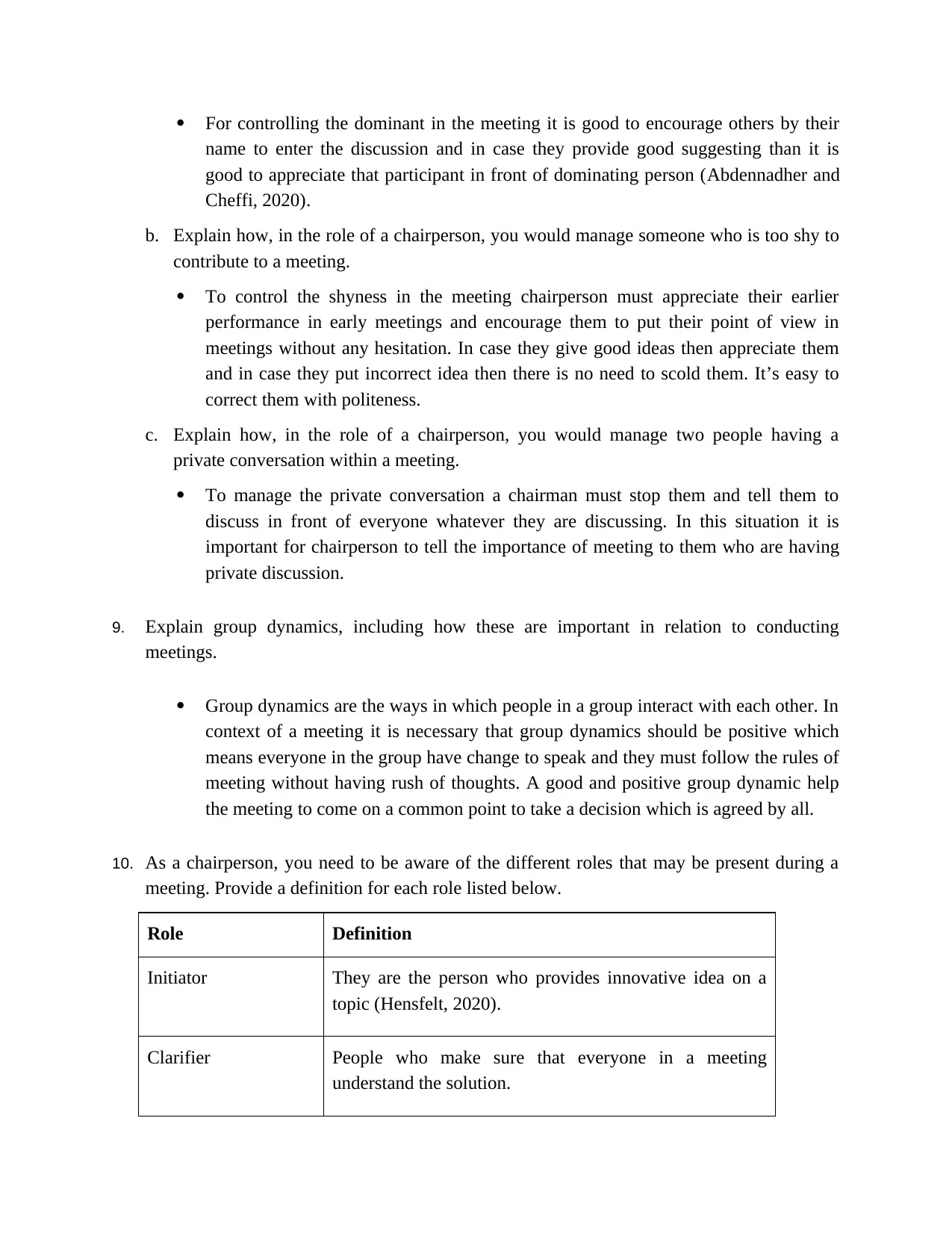
For controlling the dominant in the meeting it is good to encourage others by their
name to enter the discussion and in case they provide good suggesting than it is
good to appreciate that participant in front of dominating person (Abdennadher and
Cheffi, 2020).
b. Explain how, in the role of a chairperson, you would manage someone who is too shy to
contribute to a meeting.
To control the shyness in the meeting chairperson must appreciate their earlier
performance in early meetings and encourage them to put their point of view in
meetings without any hesitation. In case they give good ideas then appreciate them
and in case they put incorrect idea then there is no need to scold them. It’s easy to
correct them with politeness.
c. Explain how, in the role of a chairperson, you would manage two people having a
private conversation within a meeting.
To manage the private conversation a chairman must stop them and tell them to
discuss in front of everyone whatever they are discussing. In this situation it is
important for chairperson to tell the importance of meeting to them who are having
private discussion.
9. Explain group dynamics, including how these are important in relation to conducting
meetings.
Group dynamics are the ways in which people in a group interact with each other. In
context of a meeting it is necessary that group dynamics should be positive which
means everyone in the group have change to speak and they must follow the rules of
meeting without having rush of thoughts. A good and positive group dynamic help
the meeting to come on a common point to take a decision which is agreed by all.
10. As a chairperson, you need to be aware of the different roles that may be present during a
meeting. Provide a definition for each role listed below.
Role Definition
Initiator They are the person who provides innovative idea on a
topic (Hensfelt, 2020).
Clarifier People who make sure that everyone in a meeting
understand the solution.
name to enter the discussion and in case they provide good suggesting than it is
good to appreciate that participant in front of dominating person (Abdennadher and
Cheffi, 2020).
b. Explain how, in the role of a chairperson, you would manage someone who is too shy to
contribute to a meeting.
To control the shyness in the meeting chairperson must appreciate their earlier
performance in early meetings and encourage them to put their point of view in
meetings without any hesitation. In case they give good ideas then appreciate them
and in case they put incorrect idea then there is no need to scold them. It’s easy to
correct them with politeness.
c. Explain how, in the role of a chairperson, you would manage two people having a
private conversation within a meeting.
To manage the private conversation a chairman must stop them and tell them to
discuss in front of everyone whatever they are discussing. In this situation it is
important for chairperson to tell the importance of meeting to them who are having
private discussion.
9. Explain group dynamics, including how these are important in relation to conducting
meetings.
Group dynamics are the ways in which people in a group interact with each other. In
context of a meeting it is necessary that group dynamics should be positive which
means everyone in the group have change to speak and they must follow the rules of
meeting without having rush of thoughts. A good and positive group dynamic help
the meeting to come on a common point to take a decision which is agreed by all.
10. As a chairperson, you need to be aware of the different roles that may be present during a
meeting. Provide a definition for each role listed below.
Role Definition
Initiator They are the person who provides innovative idea on a
topic (Hensfelt, 2020).
Clarifier People who make sure that everyone in a meeting
understand the solution.
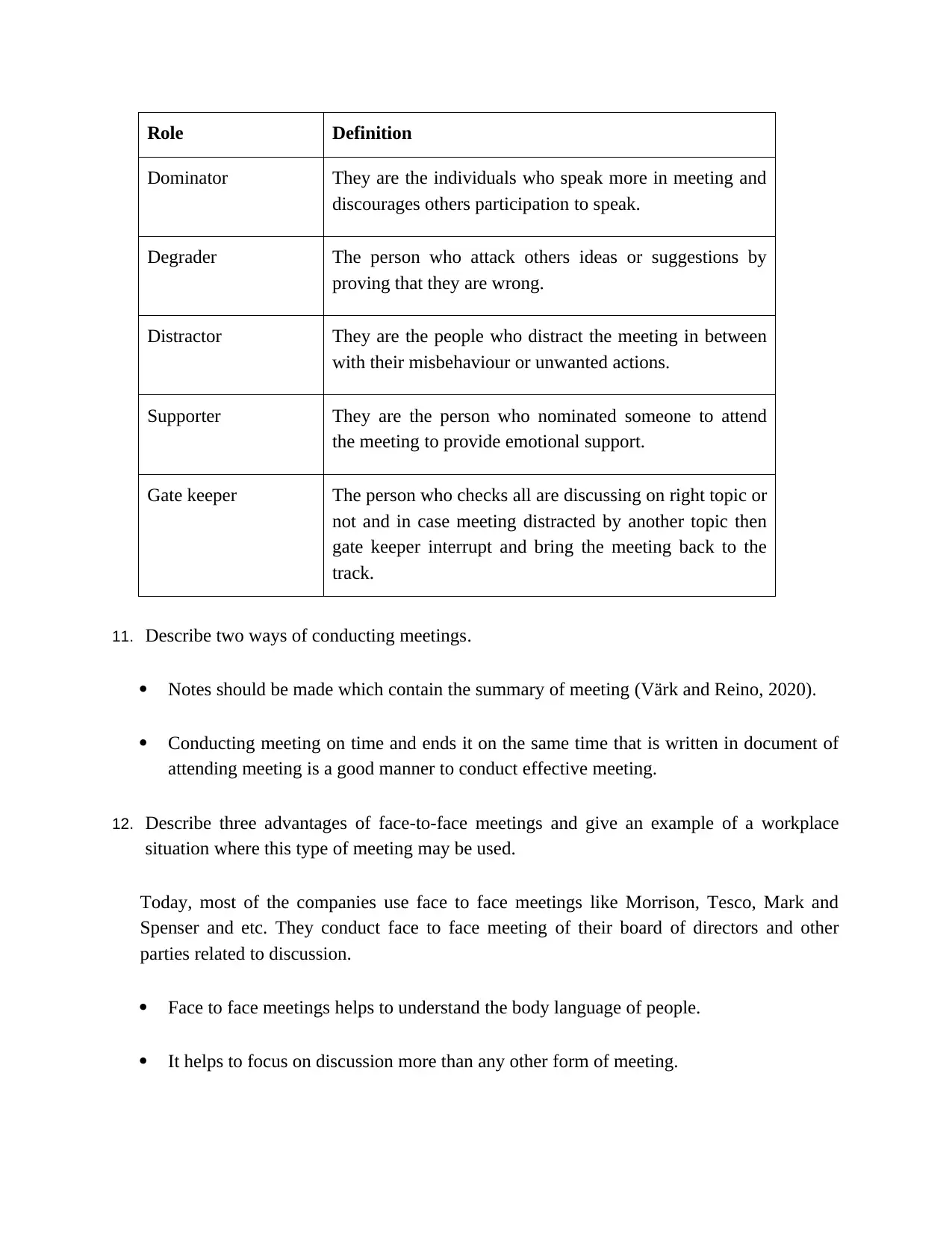
Role Definition
Dominator They are the individuals who speak more in meeting and
discourages others participation to speak.
Degrader The person who attack others ideas or suggestions by
proving that they are wrong.
Distractor They are the people who distract the meeting in between
with their misbehaviour or unwanted actions.
Supporter They are the person who nominated someone to attend
the meeting to provide emotional support.
Gate keeper The person who checks all are discussing on right topic or
not and in case meeting distracted by another topic then
gate keeper interrupt and bring the meeting back to the
track.
11. Describe two ways of conducting meetings.
Notes should be made which contain the summary of meeting (Värk and Reino, 2020).
Conducting meeting on time and ends it on the same time that is written in document of
attending meeting is a good manner to conduct effective meeting.
12. Describe three advantages of face-to-face meetings and give an example of a workplace
situation where this type of meeting may be used.
Today, most of the companies use face to face meetings like Morrison, Tesco, Mark and
Spenser and etc. They conduct face to face meeting of their board of directors and other
parties related to discussion.
Face to face meetings helps to understand the body language of people.
It helps to focus on discussion more than any other form of meeting.
Dominator They are the individuals who speak more in meeting and
discourages others participation to speak.
Degrader The person who attack others ideas or suggestions by
proving that they are wrong.
Distractor They are the people who distract the meeting in between
with their misbehaviour or unwanted actions.
Supporter They are the person who nominated someone to attend
the meeting to provide emotional support.
Gate keeper The person who checks all are discussing on right topic or
not and in case meeting distracted by another topic then
gate keeper interrupt and bring the meeting back to the
track.
11. Describe two ways of conducting meetings.
Notes should be made which contain the summary of meeting (Värk and Reino, 2020).
Conducting meeting on time and ends it on the same time that is written in document of
attending meeting is a good manner to conduct effective meeting.
12. Describe three advantages of face-to-face meetings and give an example of a workplace
situation where this type of meeting may be used.
Today, most of the companies use face to face meetings like Morrison, Tesco, Mark and
Spenser and etc. They conduct face to face meeting of their board of directors and other
parties related to discussion.
Face to face meetings helps to understand the body language of people.
It helps to focus on discussion more than any other form of meeting.
⊘ This is a preview!⊘
Do you want full access?
Subscribe today to unlock all pages.

Trusted by 1+ million students worldwide
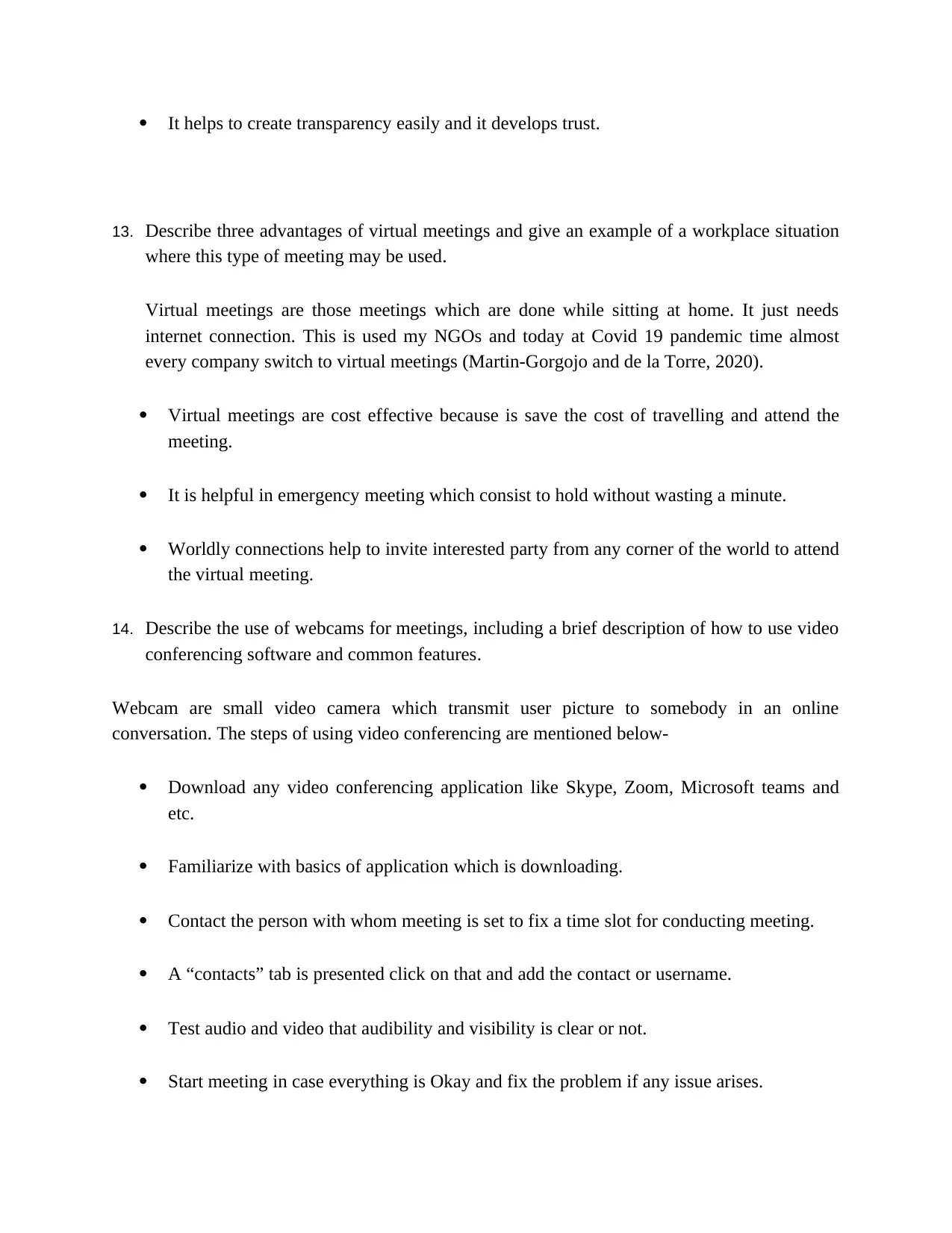
It helps to create transparency easily and it develops trust.
13. Describe three advantages of virtual meetings and give an example of a workplace situation
where this type of meeting may be used.
Virtual meetings are those meetings which are done while sitting at home. It just needs
internet connection. This is used my NGOs and today at Covid 19 pandemic time almost
every company switch to virtual meetings (Martin-Gorgojo and de la Torre, 2020).
Virtual meetings are cost effective because is save the cost of travelling and attend the
meeting.
It is helpful in emergency meeting which consist to hold without wasting a minute.
Worldly connections help to invite interested party from any corner of the world to attend
the virtual meeting.
14. Describe the use of webcams for meetings, including a brief description of how to use video
conferencing software and common features.
Webcam are small video camera which transmit user picture to somebody in an online
conversation. The steps of using video conferencing are mentioned below-
Download any video conferencing application like Skype, Zoom, Microsoft teams and
etc.
Familiarize with basics of application which is downloading.
Contact the person with whom meeting is set to fix a time slot for conducting meeting.
A “contacts” tab is presented click on that and add the contact or username.
Test audio and video that audibility and visibility is clear or not.
Start meeting in case everything is Okay and fix the problem if any issue arises.
13. Describe three advantages of virtual meetings and give an example of a workplace situation
where this type of meeting may be used.
Virtual meetings are those meetings which are done while sitting at home. It just needs
internet connection. This is used my NGOs and today at Covid 19 pandemic time almost
every company switch to virtual meetings (Martin-Gorgojo and de la Torre, 2020).
Virtual meetings are cost effective because is save the cost of travelling and attend the
meeting.
It is helpful in emergency meeting which consist to hold without wasting a minute.
Worldly connections help to invite interested party from any corner of the world to attend
the virtual meeting.
14. Describe the use of webcams for meetings, including a brief description of how to use video
conferencing software and common features.
Webcam are small video camera which transmit user picture to somebody in an online
conversation. The steps of using video conferencing are mentioned below-
Download any video conferencing application like Skype, Zoom, Microsoft teams and
etc.
Familiarize with basics of application which is downloading.
Contact the person with whom meeting is set to fix a time slot for conducting meeting.
A “contacts” tab is presented click on that and add the contact or username.
Test audio and video that audibility and visibility is clear or not.
Start meeting in case everything is Okay and fix the problem if any issue arises.
Paraphrase This Document
Need a fresh take? Get an instant paraphrase of this document with our AI Paraphraser
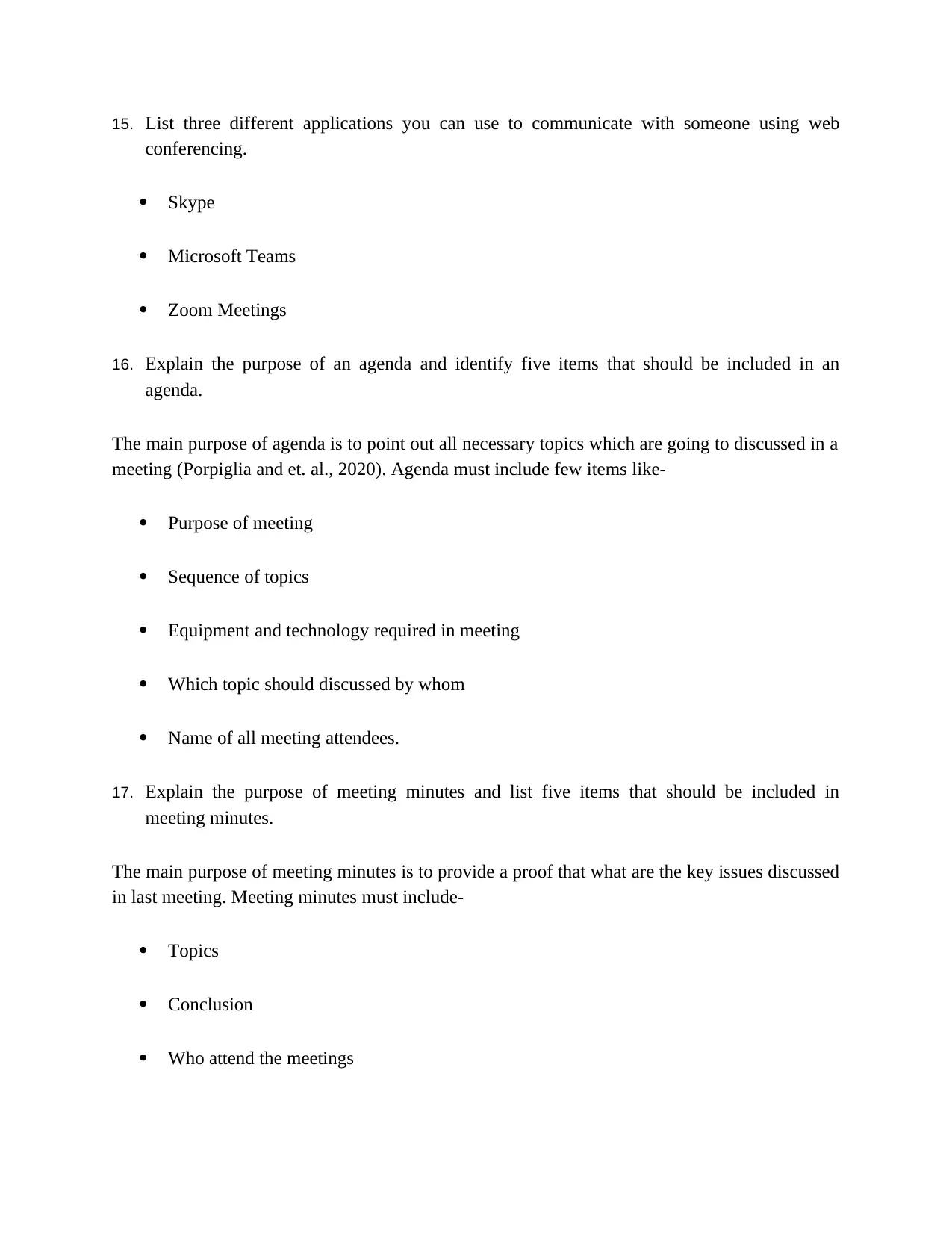
15. List three different applications you can use to communicate with someone using web
conferencing.
Skype
Microsoft Teams
Zoom Meetings
16. Explain the purpose of an agenda and identify five items that should be included in an
agenda.
The main purpose of agenda is to point out all necessary topics which are going to discussed in a
meeting (Porpiglia and et. al., 2020). Agenda must include few items like-
Purpose of meeting
Sequence of topics
Equipment and technology required in meeting
Which topic should discussed by whom
Name of all meeting attendees.
17. Explain the purpose of meeting minutes and list five items that should be included in
meeting minutes.
The main purpose of meeting minutes is to provide a proof that what are the key issues discussed
in last meeting. Meeting minutes must include-
Topics
Conclusion
Who attend the meetings
conferencing.
Skype
Microsoft Teams
Zoom Meetings
16. Explain the purpose of an agenda and identify five items that should be included in an
agenda.
The main purpose of agenda is to point out all necessary topics which are going to discussed in a
meeting (Porpiglia and et. al., 2020). Agenda must include few items like-
Purpose of meeting
Sequence of topics
Equipment and technology required in meeting
Which topic should discussed by whom
Name of all meeting attendees.
17. Explain the purpose of meeting minutes and list five items that should be included in
meeting minutes.
The main purpose of meeting minutes is to provide a proof that what are the key issues discussed
in last meeting. Meeting minutes must include-
Topics
Conclusion
Who attend the meetings
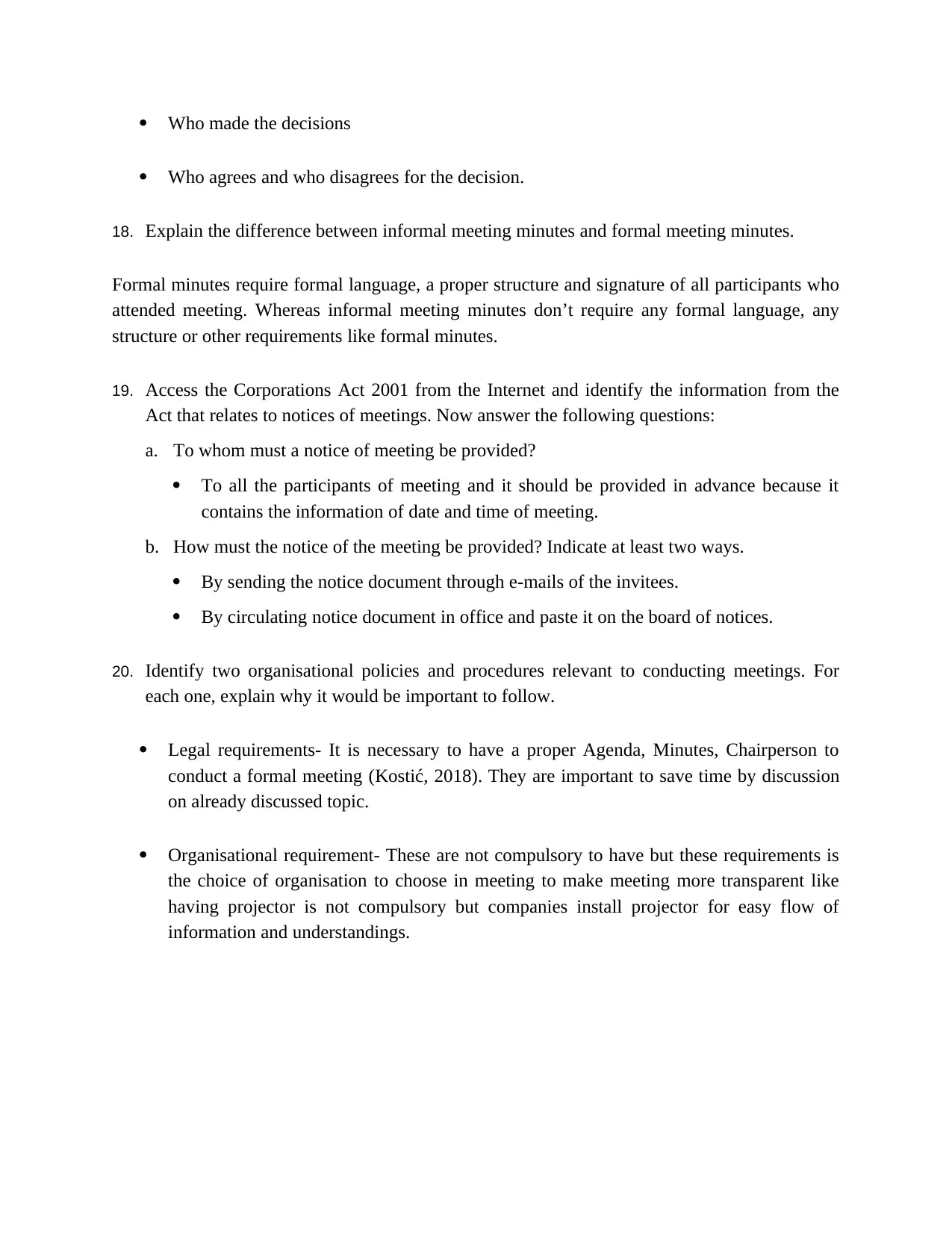
Who made the decisions
Who agrees and who disagrees for the decision.
18. Explain the difference between informal meeting minutes and formal meeting minutes.
Formal minutes require formal language, a proper structure and signature of all participants who
attended meeting. Whereas informal meeting minutes don’t require any formal language, any
structure or other requirements like formal minutes.
19. Access the Corporations Act 2001 from the Internet and identify the information from the
Act that relates to notices of meetings. Now answer the following questions:
a. To whom must a notice of meeting be provided?
To all the participants of meeting and it should be provided in advance because it
contains the information of date and time of meeting.
b. How must the notice of the meeting be provided? Indicate at least two ways.
By sending the notice document through e-mails of the invitees.
By circulating notice document in office and paste it on the board of notices.
20. Identify two organisational policies and procedures relevant to conducting meetings. For
each one, explain why it would be important to follow.
Legal requirements- It is necessary to have a proper Agenda, Minutes, Chairperson to
conduct a formal meeting (Kostić, 2018). They are important to save time by discussion
on already discussed topic.
Organisational requirement- These are not compulsory to have but these requirements is
the choice of organisation to choose in meeting to make meeting more transparent like
having projector is not compulsory but companies install projector for easy flow of
information and understandings.
Who agrees and who disagrees for the decision.
18. Explain the difference between informal meeting minutes and formal meeting minutes.
Formal minutes require formal language, a proper structure and signature of all participants who
attended meeting. Whereas informal meeting minutes don’t require any formal language, any
structure or other requirements like formal minutes.
19. Access the Corporations Act 2001 from the Internet and identify the information from the
Act that relates to notices of meetings. Now answer the following questions:
a. To whom must a notice of meeting be provided?
To all the participants of meeting and it should be provided in advance because it
contains the information of date and time of meeting.
b. How must the notice of the meeting be provided? Indicate at least two ways.
By sending the notice document through e-mails of the invitees.
By circulating notice document in office and paste it on the board of notices.
20. Identify two organisational policies and procedures relevant to conducting meetings. For
each one, explain why it would be important to follow.
Legal requirements- It is necessary to have a proper Agenda, Minutes, Chairperson to
conduct a formal meeting (Kostić, 2018). They are important to save time by discussion
on already discussed topic.
Organisational requirement- These are not compulsory to have but these requirements is
the choice of organisation to choose in meeting to make meeting more transparent like
having projector is not compulsory but companies install projector for easy flow of
information and understandings.
⊘ This is a preview!⊘
Do you want full access?
Subscribe today to unlock all pages.

Trusted by 1+ million students worldwide
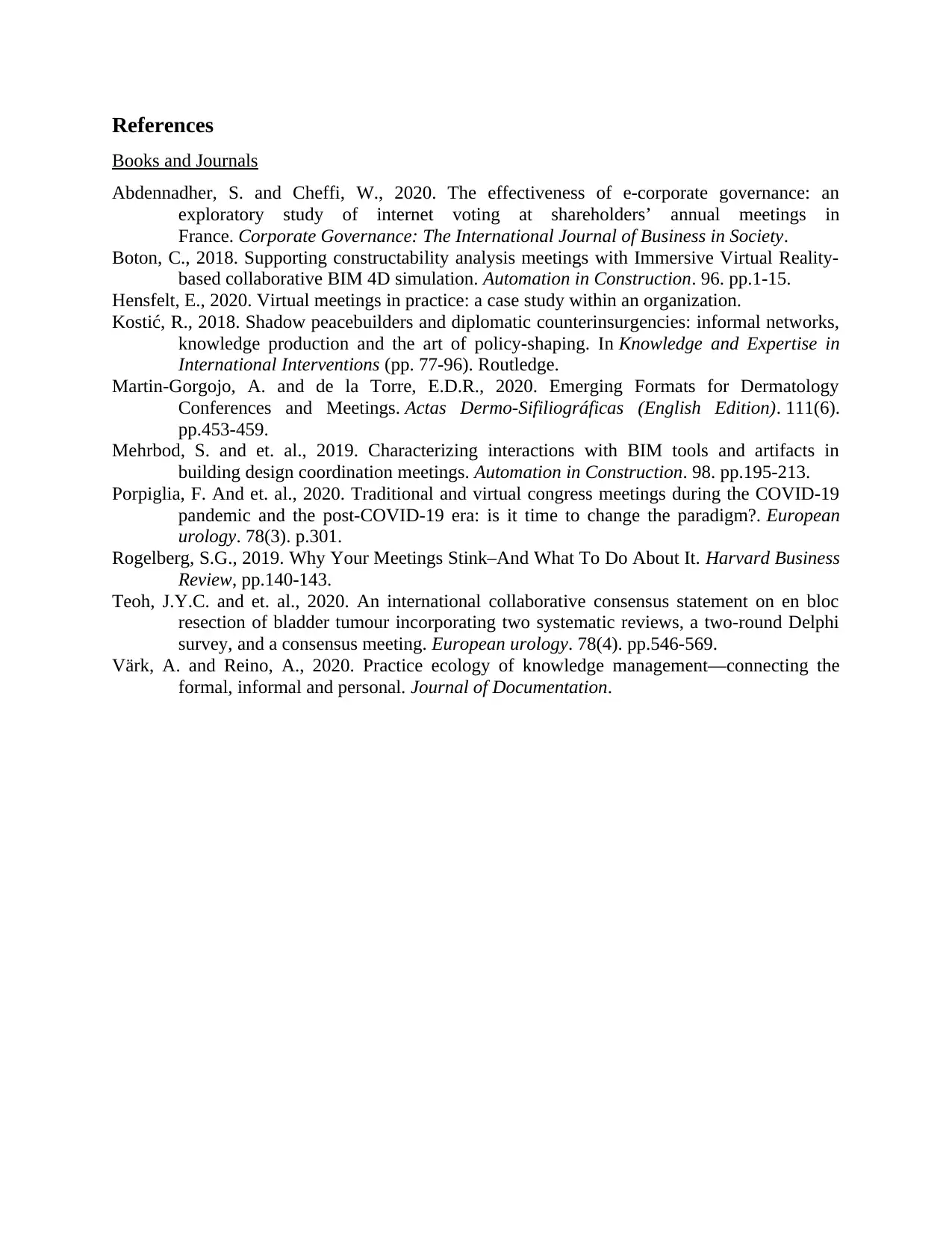
References
Books and Journals
Abdennadher, S. and Cheffi, W., 2020. The effectiveness of e-corporate governance: an
exploratory study of internet voting at shareholders’ annual meetings in
France. Corporate Governance: The International Journal of Business in Society.
Boton, C., 2018. Supporting constructability analysis meetings with Immersive Virtual Reality-
based collaborative BIM 4D simulation. Automation in Construction. 96. pp.1-15.
Hensfelt, E., 2020. Virtual meetings in practice: a case study within an organization.
Kostić, R., 2018. Shadow peacebuilders and diplomatic counterinsurgencies: informal networks,
knowledge production and the art of policy-shaping. In Knowledge and Expertise in
International Interventions (pp. 77-96). Routledge.
Martin-Gorgojo, A. and de la Torre, E.D.R., 2020. Emerging Formats for Dermatology
Conferences and Meetings. Actas Dermo-Sifiliográficas (English Edition). 111(6).
pp.453-459.
Mehrbod, S. and et. al., 2019. Characterizing interactions with BIM tools and artifacts in
building design coordination meetings. Automation in Construction. 98. pp.195-213.
Porpiglia, F. And et. al., 2020. Traditional and virtual congress meetings during the COVID-19
pandemic and the post-COVID-19 era: is it time to change the paradigm?. European
urology. 78(3). p.301.
Rogelberg, S.G., 2019. Why Your Meetings Stink–And What To Do About It. Harvard Business
Review, pp.140-143.
Teoh, J.Y.C. and et. al., 2020. An international collaborative consensus statement on en bloc
resection of bladder tumour incorporating two systematic reviews, a two-round Delphi
survey, and a consensus meeting. European urology. 78(4). pp.546-569.
Värk, A. and Reino, A., 2020. Practice ecology of knowledge management—connecting the
formal, informal and personal. Journal of Documentation.
Books and Journals
Abdennadher, S. and Cheffi, W., 2020. The effectiveness of e-corporate governance: an
exploratory study of internet voting at shareholders’ annual meetings in
France. Corporate Governance: The International Journal of Business in Society.
Boton, C., 2018. Supporting constructability analysis meetings with Immersive Virtual Reality-
based collaborative BIM 4D simulation. Automation in Construction. 96. pp.1-15.
Hensfelt, E., 2020. Virtual meetings in practice: a case study within an organization.
Kostić, R., 2018. Shadow peacebuilders and diplomatic counterinsurgencies: informal networks,
knowledge production and the art of policy-shaping. In Knowledge and Expertise in
International Interventions (pp. 77-96). Routledge.
Martin-Gorgojo, A. and de la Torre, E.D.R., 2020. Emerging Formats for Dermatology
Conferences and Meetings. Actas Dermo-Sifiliográficas (English Edition). 111(6).
pp.453-459.
Mehrbod, S. and et. al., 2019. Characterizing interactions with BIM tools and artifacts in
building design coordination meetings. Automation in Construction. 98. pp.195-213.
Porpiglia, F. And et. al., 2020. Traditional and virtual congress meetings during the COVID-19
pandemic and the post-COVID-19 era: is it time to change the paradigm?. European
urology. 78(3). p.301.
Rogelberg, S.G., 2019. Why Your Meetings Stink–And What To Do About It. Harvard Business
Review, pp.140-143.
Teoh, J.Y.C. and et. al., 2020. An international collaborative consensus statement on en bloc
resection of bladder tumour incorporating two systematic reviews, a two-round Delphi
survey, and a consensus meeting. European urology. 78(4). pp.546-569.
Värk, A. and Reino, A., 2020. Practice ecology of knowledge management—connecting the
formal, informal and personal. Journal of Documentation.
1 out of 10
Related Documents
Your All-in-One AI-Powered Toolkit for Academic Success.
+13062052269
info@desklib.com
Available 24*7 on WhatsApp / Email
![[object Object]](/_next/static/media/star-bottom.7253800d.svg)
Unlock your academic potential
Copyright © 2020–2025 A2Z Services. All Rights Reserved. Developed and managed by ZUCOL.





